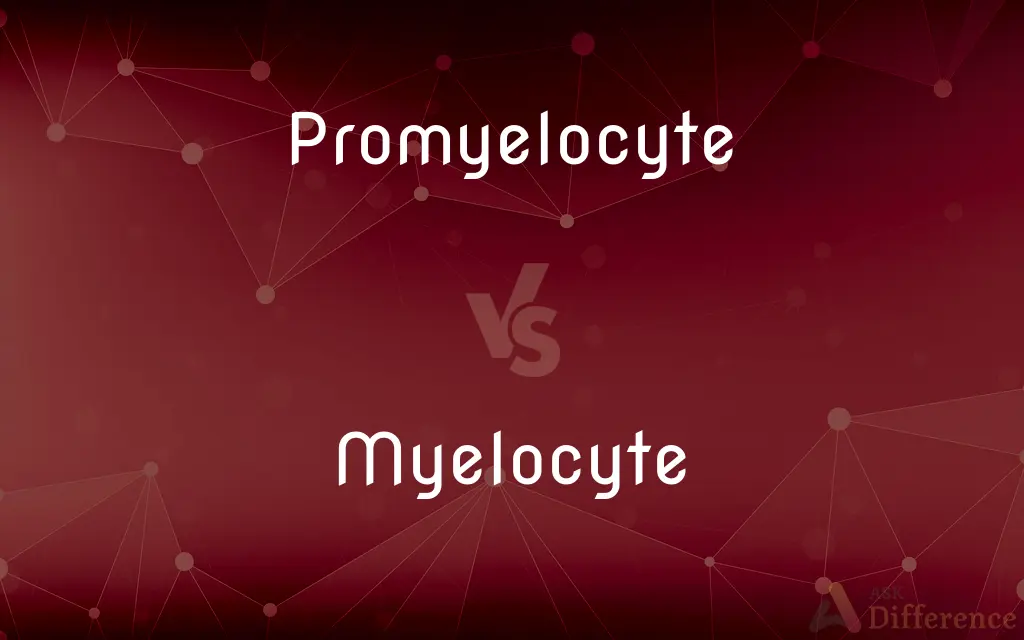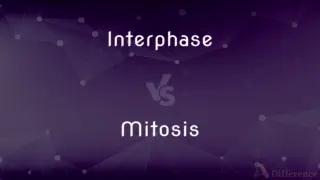Promyelocyte vs. Myelocyte — What's the Difference?
Edited by Tayyaba Rehman — By Fiza Rafique — Updated on March 13, 2024
Promyelocytes are an earlier stage in the development of blood cells, just after myeloblasts, while myelocytes are the next stage, developing from promyelocytes.

Difference Between Promyelocyte and Myelocyte
Table of Contents
ADVERTISEMENT
Key Differences
Promyelocytes are immature white blood cells found in the bone marrow, representing an early stage in the granulocyte series of hematopoiesis. They follow myeloblasts in the development sequence. On the other hand, myelocytes are the subsequent developmental stage after promyelocytes, where these cells begin to differentiate more distinctly into neutrophils, eosinophils, or basophils.
In terms of morphology, promyelocytes are characterized by a large nucleus and the presence of primary (or azurophilic) granules in their cytoplasm, which are not specific to any type of granulocyte. Myelocytes, however, start to show specific secondary granules that determine their line of differentiation, indicating a further commitment to becoming a specific type of white blood cell.
The size of a promyelocyte typically ranges from 12 to 20 micrometers in diameter, making them one of the larger cells in the granulocytic series. Myelocytes are slightly smaller, generally ranging from 10 to 18 micrometers, as the cell begins to condense and mature.
Promyelocytes are primarily involved in the synthesis of granules that play a role in the cell's immune functions. As these cells mature into myelocytes, the focus shifts more towards the development of specific granules that will define the cell's specific function in the immune response, such as combating parasites or modulating allergic reactions.
In clinical terms, an abnormal increase in promyelocytes can be indicative of certain types of leukemia, such as acute promyelocytic leukemia (APL), which is a distinct subtype characterized by a specific chromosomal translocation. An increase in myelocytes, on the other hand, can be seen in various conditions, including chronic myelogenous leukemia (CML) and other myeloproliferative disorders, reflecting a disruption in the normal maturation process of blood cells.
ADVERTISEMENT
Comparison Chart
Development Stage
Early stage in granulocyte development
Follows promyelocytes, further along in development
Morphology
Large nucleus, primary granules
Specific secondary granules start to appear
Size
12-20 micrometers in diameter
10-18 micrometers in diameter
Function
Synthesis of primary granules
Development of specific granules for immune response
Clinical Significance
Abnormal increase can indicate APL
Abnormal increase seen in CML and other disorders
Compare with Definitions
Promyelocyte
Early white blood cell stage.
Promyelocytes follow myeloblasts in the bone marrow's white blood cell development process.
Myelocyte
Mid-stage white blood cell development.
Myelocytes are developed from promyelocytes and precede metamyelocytes in white blood cell maturation.
Promyelocyte
Large size.
Promyelocytes are relatively large, with diameters ranging from 12 to 20 micrometers.
Myelocyte
Secondary granules appear.
Specific granules begin to form in myelocytes, indicating the cell's future function.
Promyelocyte
Indicator of certain leukemias.
An increase in promyelocytes can be a marker for acute promyelocytic leukemia (APL).
Myelocyte
Slightly smaller than promyelocytes.
Myelocytes are typically 10 to 18 micrometers in diameter, showing signs of cell condensation.
Promyelocyte
Characterized by primary granules.
The cytoplasm of promyelocytes is filled with primary, non-specific granules.
Myelocyte
Specific immune function development.
The presence of specific granules in myelocytes is crucial for their specialized roles in the immune system.
Promyelocyte
Granule synthesis.
These cells are responsible for synthesizing primary granules important for immune functions.
Myelocyte
Associated with various blood disorders.
Elevated levels of myelocytes can be found in conditions like chronic myelogenous leukemia.
Promyelocyte
A promyelocyte (or progranulocyte) is a granulocyte precursor, developing from the myeloblast and developing into the myelocyte. Promyelocytes measure 12-20 microns in diameter.
Myelocyte
A myelocyte is a young cell of the granulocytic series, occurring normally in bone marrow (can be found in circulating blood when caused by certain diseases).
Promyelocyte
A granulocyte precursor, developing from the myeloblast and developing into the myelocyte.
Myelocyte
A large cell of the bone marrow that is a precursor of the neutrophils and other granulocytes of the blood.
Myelocyte
A large cell, found in bone marrow, that becomes a granulocyte when mature
Myelocyte
A cell associated with the myelin of the brain and spinal cord
Myelocyte
An immature leukocyte normally found in bone marrow
Common Curiosities
What happens after a myelocyte stage in blood cell development?
Myelocytes mature into metamyelocytes, then into band cells, and finally into mature granulocytes (neutrophils, eosinophils, or basophils).
Can the presence of too many promyelocytes or myelocytes be harmful?
Yes, an abnormal increase can indicate blood disorders like leukemia, affecting the body's ability to produce healthy blood cells.
What distinguishes a promyelocyte from a myelocyte?
Promyelocytes are an earlier developmental stage with primary granules, while myelocytes are further along and develop specific secondary granules.
Can promyelocyte and myelocyte counts change with infections?
Yes, their counts can increase during infections as part of the body's immune response, but should return to normal afterwards.
What triggers the development of myelocytes from promyelocytes?
Cellular signals and genetic factors regulate the maturation process, guiding the development from promyelocytes to myelocytes.
How are promyelocytes and myelocytes used in diagnosing diseases?
Their levels and appearances in bone marrow examinations can help diagnose and characterize various hematological diseases.
Why are promyelocytes important in the immune system?
They synthesize primary granules that are crucial for the cell's initial immune functions.
How do myelocytes contribute to the body's defense?
Myelocytes develop specific granules that define their role in combating infections, allergies, or inflammation.
Are promyelocytes visible in regular blood tests?
Typically, they are not found in peripheral blood and are primarily located in the bone marrow.
What role do environmental factors play in promyelocyte and myelocyte development?
Environmental factors can influence overall bone marrow function but do not directly alter the specific progression from promyelocyte to myelocyte.
Can lifestyle choices impact the levels of promyelocytes and myelocytes?
Indirectly, as overall health and bone marrow function can be affected by lifestyle choices, potentially impacting cell production.
How does the body regulate the number of promyelocytes and myelocytes?
The body regulates these cells through complex hormonal and cellular feedback mechanisms that ensure balanced production.
Are there any genetic conditions that specifically affect promyelocytes or myelocytes?
Certain genetic abnormalities can disrupt the normal development of these cells, leading to specific types of leukemia or other hematological conditions.
Is the transition from promyelocyte to myelocyte reversible?
No, the maturation process is unidirectional, moving from promyelocyte to myelocyte and beyond.
What advancements have been made in treating disorders involving promyelocytes and myelocytes?
Treatments have improved with better understanding of the genetic and molecular basis of related diseases, leading to targeted therapies.
Share Your Discovery

Previous Comparison
Interphase vs. Mitosis
Next Comparison
From vs. AgainstAuthor Spotlight
Written by
Fiza RafiqueFiza Rafique is a skilled content writer at AskDifference.com, where she meticulously refines and enhances written pieces. Drawing from her vast editorial expertise, Fiza ensures clarity, accuracy, and precision in every article. Passionate about language, she continually seeks to elevate the quality of content for readers worldwide.
Edited by
Tayyaba RehmanTayyaba Rehman is a distinguished writer, currently serving as a primary contributor to askdifference.com. As a researcher in semantics and etymology, Tayyaba's passion for the complexity of languages and their distinctions has found a perfect home on the platform. Tayyaba delves into the intricacies of language, distinguishing between commonly confused words and phrases, thereby providing clarity for readers worldwide.














































